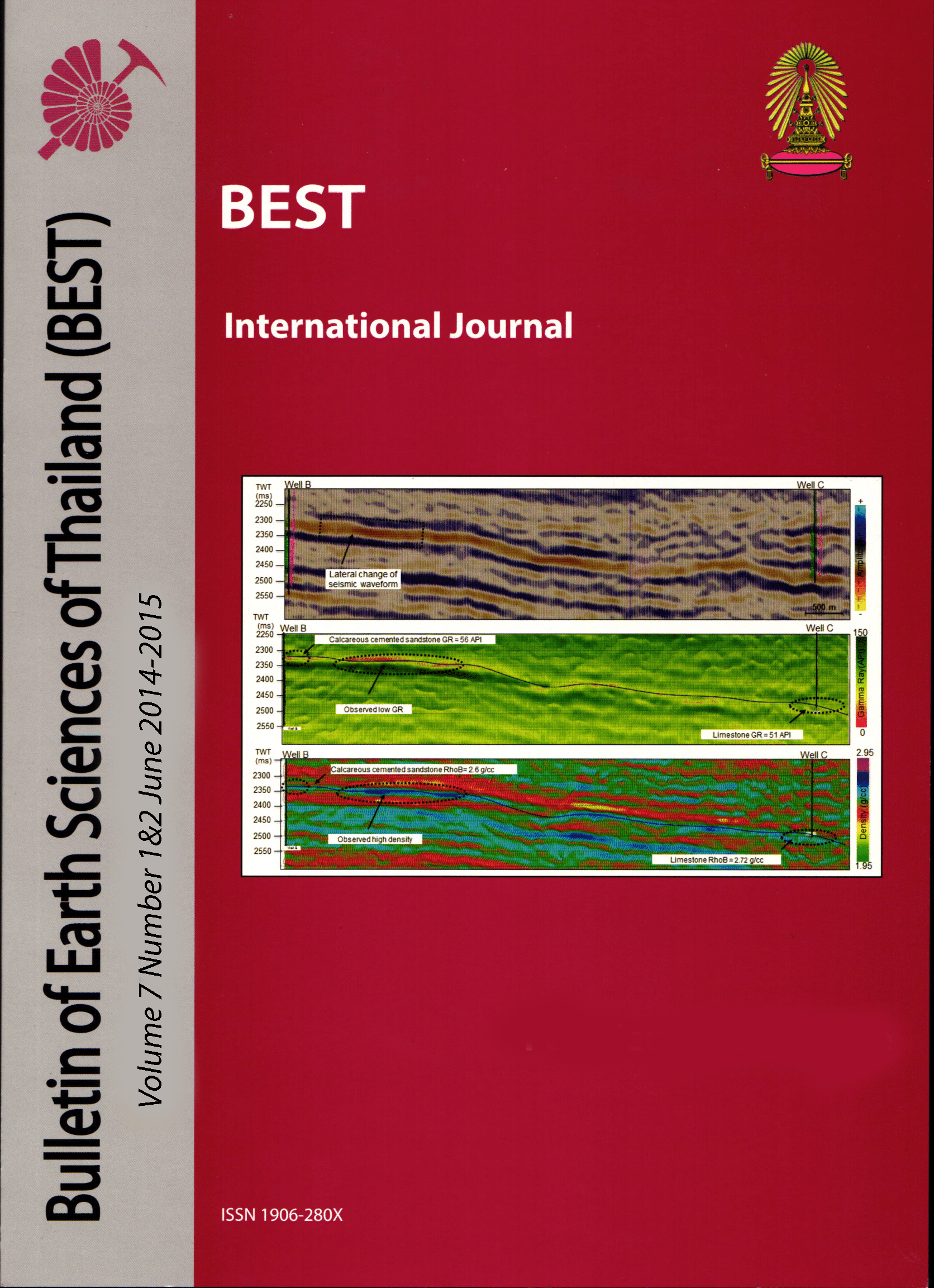SEQUENCE STRATIGRAPHIC STUDY AND SEISMIC IMAGING OF PLIOCENE LOWSTAND DEPOSITS IN OFFSHORE VIETNAM
Main Article Content
Abstract
Channels and basin floor fans are not only excellent evidences for analyzing the lowstand system tract but also common objectives in the oil and gas industry. Incised valleys or channel cuts and basin floor fans of this study area were observed and interpreted based on general 3D seismic data. Combining of seismic attributes and well data are used to predict their distributions as well as their lithology. In addition, evolutions of channels and basin floor fans through time were determined by using time slices or horizon slices of the seismic attribute cube association by shifting a window above a surface and displaying it as the RMS (root mean square) of amplitude over a specific interval. This study concentrated on sequence stratigraphy in terms of combining all data such as seismic and well log data to understand the processes and depositional environments of sequences. The sequences were interpreted by looking for channels or incised valleys and basin floor fans development from Pliocene to Recent time of this area. This research also discussed about primal factors, which affect depositional principles. There are relationships of relative sea level, sediment loading and subsidence rate to these sequences. In addition, relative ages of sequence S3 and S4 could be correlated with the published sea level curve of Wornardt et al., 2001. Channels and basin floor fans are displayed on the Gross Depositional Environment map. The maps are used to demonstrate the processes controlling the channels and basin floor fans.
Article Details

This work is licensed under a Creative Commons Attribution-NonCommercial-NoDerivatives 4.0 International License.
Copyright © 2008 Department of Geology, Faculty of Science, Chulalongkorn University. Parts of an article can be photocopied or reproduced without prior written permission from the author(s), but due acknowledgments should be stated or cited accordingly.
References
Catuneanu, O., 2006, Principal of sequence stratigraphy, Elsevier Science publisher B.V., 1000 AE Amsterdam, the Netherlands, 387 p.
Christine M. Wright, 2006. Neogene Stratigraphy relationships within the Nam Con Son Basin, offshore Vietnam resulting from tectonics, eustasy, and sediment flux: PhD thesis, A&M University, Texas.
Emery, D. and Myers, K. J. 1996, Sequence Stratigraphy, Blackwell Science Ltd, 25 John Street, 264 p.
Katz, B., 2001. Lacustrine basin hydrocarbon exploration - Current thoughts. J. Paleolimnol. 26 (2), 161-179. Kirby, G A. and Evans, D J., 1995. Sequence stratigraphiy of hydrocarbon basins of SE Asia. Energy Efficiency. R5559, Chapter 2, 3.
Mattern, F., 2005. Ancient sand-rich submarine fans: depositional systems, models, identification, and analysis. Earth-Sci. Rev. 70 (3-4), 167-202.
Pratson, L.F., Coakley, B.J., 1996. A model for the headward erosion of submarine canyons induced by downslope-eroding sediment flows. Geological Society of America Bulletin 108, 225-234.
Shepard, F.P., 1981. Submarine canyons; multiple causes and long-time persistence. American Association of Petroleum Geologists Bulletin 65, 106-1077.
Sotak, J., Pereszlenyi, M., Marschalko, R., Milicka, J., Starek, D., 2001. Sedimentology and hydrocarbon habitat of the submarine-fan deposits of the Central Carpathian Paleogene Basin (NE Slovakia). Mar. Pet. Geol. 18 (1), 87-114.
Suess E. 1888. Das Anlitz der Erde, II Die Meere der Erde, Wien. Tanner, W. F. 1968. Teriary sea level symposium, Palaeogeogr. Palaeoclimate., Palaeoecol., 5.
Twichell, D.C., Roberts, D.G., 1982. Morphology, distribution, and development of submarine canyons on the United States Atlantic continental slope between Hudson and Baltimore canyons. Geology 10, 408-412.
Vail, P. R., Mitchum, R. M. Jr., and Thompson, S., 1977, Seismic stratigraphy and global changes of sea level, Part 3: Relative changes of sea level from coastal onlap, in C. E Payton, ed., Seismic Stratigraphy-Applications to Hydrocarbon Exploration, AAPG Memoir 26, p. 63-81.
Veeken, P. and Van Moerkerken, B., 2013. Seismic stratigraphy and Depositional facies models: EAGE and Elsevier Scientific Publishers, p. 107 - 213.
Walter W. Wornardt Jr, Bernie Shaffer, Peter R. Vail, 2001, Revision of the late Miocene, Pliocene and Pleistocene Sequence Cycles, Gulf coast association of Geological Societies Transaction, Volume LI, p. 478.
Wang, J., Chen, H., Wang, H., Jiang, T., Miao, H., Shang, Y., 2009. Depositional characteristics of the large-scale sublacustrine fan at member Yong 1 of the Yitong Graben and its response to tectonic events. ACTA GEOL. SIN. 83 (4), 550-557 (in Chinese with English Abstract).


